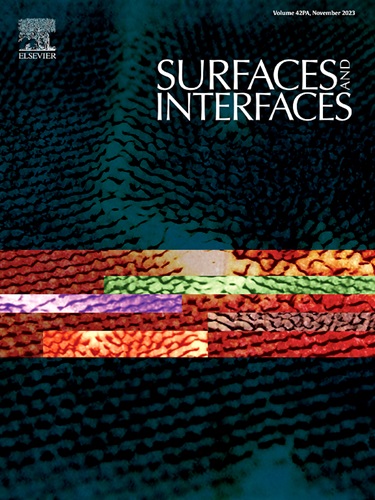Regulation of extracellular electron transfer by sustained existence of Fe²⁺/Fe³⁺ redox couples on iron oxide-functionalized woody biochar anode surfaces in bioelectrochemical systems
IF 5.7
2区 材料科学
Q2 CHEMISTRY, PHYSICAL
引用次数: 0
Abstract
Sluggish extracellular electron transfer between the exoelectrogens and anode interface limits the application of bioelectrochemical systems (BECs) for energy generation. In this study, an innovative anode coated with oxidized biochar and co-functionalized with iron nanoparticles (FBC/Fe2O3) was developed to enhance microbial reactions through tuned physicochemical and electrical properties. The designed anode features a highly porous, heterogeneous structure with a large accessible surface area of 10.141 m²/g, promoting better habitation and metabolism of exoelectrogens. The synergistic effect of iron nanoparticles and oxidized functional groups increased the hydrophilicity of the anode surface, augmenting its affinity for bacterial outer membrane c-cysts and facilitating microbial adhesion at a density of 3.106 × 10⁹ CFU/cm². The iron moieties on the FBC/Fe2O3 electrode surface act as electron mediators, utilizing Fe²⁺/Fe³⁺ redox couples, as evidenced by X-ray photoelectron spectroscopy (XPS) data. This enhancement improved extracellular electron transfer (EET) between bacterial cells and the anode surface, resulting in a faster and bifurcated EET process through both direct transfer via outer membrane c-cysts and mediated transfer via the redox couples of Fe moieties. The assembled double-chamber microbial fuel cell (DC-MFC) with the FBC/Fe2O3 anode achieved a maximum power density of 528.75 mW/m² and a chemical oxygen demand (COD) removal efficiency of 47.5 % within 24 h of operation.
生物电化学系统中氧化铁功能化木质生物炭阳极表面持续存在的 Fe²⁺/Fe³⁺ 氧化还原偶,可调节细胞外电子转移
细胞外电子原体与阳极界面之间缓慢的细胞外电子转移限制了生物电化学系统(BEC)在能源生产方面的应用。本研究开发了一种涂有氧化生物炭并与纳米铁粒子(FBC/Fe2O3)共官能化的创新阳极,通过调整物理化学和电学特性来增强微生物反应。所设计的阳极具有高度多孔的异质结构,具有 10.141 m²/g 的大可触及表面积,可促进外源物质更好地栖息和新陈代谢。铁纳米颗粒和氧化功能基团的协同作用增加了阳极表面的亲水性,增强了其对细菌外膜 c-cysts 的亲和力,有利于微生物的粘附,密度为 3.106 × 10𠞙 CFU/cm²。X 射线光电子能谱(XPS)数据证明,FBC/Fe2O3 电极表面的铁分子利用 Fe²⁺/Fe³⁺ 氧化还原偶作为电子介质。这种增强改善了细菌细胞与阳极表面之间的胞外电子传递(EET),通过外膜 c-cysts 的直接传输和铁分子氧化还原偶的介导传输,使 EET 过程更快、更分叉。装配了 FBC/Fe2O3 阳极的双室微生物燃料电池(DC-MFC)在运行 24 小时内的最大功率密度达到 528.75 mW/m²,化学需氧量(COD)去除率达到 47.5%。
本文章由计算机程序翻译,如有差异,请以英文原文为准。
求助全文
约1分钟内获得全文
求助全文
来源期刊

Surfaces and Interfaces
Chemistry-General Chemistry
CiteScore
8.50
自引率
6.50%
发文量
753
审稿时长
35 days
期刊介绍:
The aim of the journal is to provide a respectful outlet for ''sound science'' papers in all research areas on surfaces and interfaces. We define sound science papers as papers that describe new and well-executed research, but that do not necessarily provide brand new insights or are merely a description of research results.
Surfaces and Interfaces publishes research papers in all fields of surface science which may not always find the right home on first submission to our Elsevier sister journals (Applied Surface, Surface and Coatings Technology, Thin Solid Films)
 求助内容:
求助内容: 应助结果提醒方式:
应助结果提醒方式:


